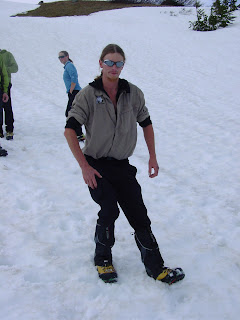The plunge step is a simple technique for walking downhill in the snow. However, it is one of those techniques that seems relatively straight-forward in certain snow types, while difficult in others.
To do a standard plunge step, stand with your feet shoulder width apart. Bend your knees and drop your rear end. As you step down the hill during your descent, be sure to lead with the heel of your foot. The heel of your boot should be like a dagger, the pointy section of the heel slicing into the snow first.
In soft snow, this technique is relatively easy to understand. On our courses, we will often play games of Red Light/Green Light with students racing down the hill. In soft snow, everybody tends to stay on their feet and in control when we say red light. Hard snow is a different story. It's not uncommon to see people slip and fall trying to plunge step in such conditions. And sometimes it can be quite amusing to play Red Light/Green Light in such conditions...
In hard conditions, it's not uncommon for people to become tentative in their steps. Such movement can cause an individual to be more likely to slip as opposed to less likely. Occasionally this develops into a dangerous and frustrating cycle. A climber slips once, becomes more tentative, slips again, and becomes even more tentative, creating yet even a higher likelihood of slipping. The only way to kill this potentially hazardous cycle is to become more aggressive, stabbing your foot deeply into the snow no matter how hard it is.
Moving effectively in the snow is one of the most important things that climbers do. And learning to employ a solid plunge step in all the different kinds of conditions that you might encounter can only help you to become a faster and more solid climber.
--Jason D. Martin
Lưu trữ Blog
-
▼
2010
(3068)
-
▼
tháng 8
(230)
- My Sore Patchanga (and it's not what you think)
- Netflix comes to Apple TV
- Coach Cupcake Charm
- Tennessee Food Round Up
- Vattenlöpning och myggbett
- Golden Eagle Nest Work
- Steve Jobs is Lucifer!
- FeelthemupFriday
- Your Assistance Required
- foxy digitalis
- PHOTOGRAPHY BY AIMEE BRODEUR
- Olé, Y'aaaaaaaaaaaaal
- Speed..
- The numbskull rally
- Cupcake Lip Gloss
- The Mountaineer's Rest Step
- Week Ending August 29
- What DIDN'T I do this weekend.......
- Intensivt
- Comanche Peak Loop
- September and October Climbing Events
- Rosa dygnet
- Waiting for the big reveal
- Summer's end
- Mrs Woog. Fashion Reporter. kind of......
- Playlist - 28th August 2010
- Kallt, höstigt, underbart!
- Saturdays with SawHole # 10
- Cover Photo Contest!
- Guesting
- När man är förkyld får man tröstshoppa!
- MidTown
- Jag var bara tvungen att skriva av mig lite
- We may have to pop your eye out!
- Climbing and Outdoor News from Here and Abroad - 8...
- Netflix now available on your iPhone and iPod touch
- MAGIC KIDS - MEMPHIS
- Giant sticks?
- Missing Day Hiker Walks into Toklat Road Camp
- In the style of a crab.....
- West Village, Charles St.
- Lite halvkrassligt
- Search Underway in Denali National Park for Missin...
- Conditions Report - August 25 2010
- Kidspot Top 50 Blog Your Way To Dunk Island
- My favorite movie- the best of all time
- Week Ending August 22
- Dålig tajming
- Riding Down Manhattan
- At the south edge of central park
- We are the champions
- The Piton
- Sponsored Post- I love Bega as much as my Tupperware.
- PHOTOGRAPHY BY MIKE BAILEY GATES
- Personality test
- Har jag sagt att jag gillar djur föresten?
- Sovdag önskas
- Woog in Profile # 4
- Augmented Metropolis
- Not an election blog
- Insect Repellent
- A STEREOTYPE CLUB 20.8.
- Guest Post: The glamour of writing ;)
- The Expansion of Rick Mahorn
- Söndag, måndag
- Pikes Peak Marathon 2010
- Digestive aids - Mountain Gorilla - BBC Two
- Climbing essentials - Mountain Gorilla - BBC Two
- 7 Nights in Phuket + Giveaway
- Pallet House
- The Trogs may have landed
- August and September Climbing Events
- Swearing, my mother and writing
- Lite suddiga pics
- Hives and valves, filters and membranes
- My Wedding Cupcake Tower
- The Bedforder
- 10km glädje
- Playlist - 21st August 2010
- The Card that Sums Up Joe Kleine's Career
- Weekend Warrior - Videos to get you stoked!
- SUFJAN STEVENS - ALL DELIGHTED PEOPLE
- Jag tror det blir start
- Car Jack Planet
- Saturdays with SawHole # 9
- From the Collection: Basketball & Other edition
- DOWN TOWN
- South Williamsburg along Wythe
- Ratchets for Rescue
- There are Kangaroos in Austria!
- Glass Half Full - Andrew Kirk
- Không có tiêu đề
- Pikes Peak Thoughts
- Längesen vi sågs
- The world has kept moving and I have fallen off
- Icosium tomentosum
- Climbing and Outdoor News from Here and Abroad - 8...
- A STEREOTYPE CLUB : BIG WAVE RIDERS - "SKATE OR DIE"
- Descent into hell TGIF
- Waxing Lyrical About Sales People
-
▼
tháng 8
(230)